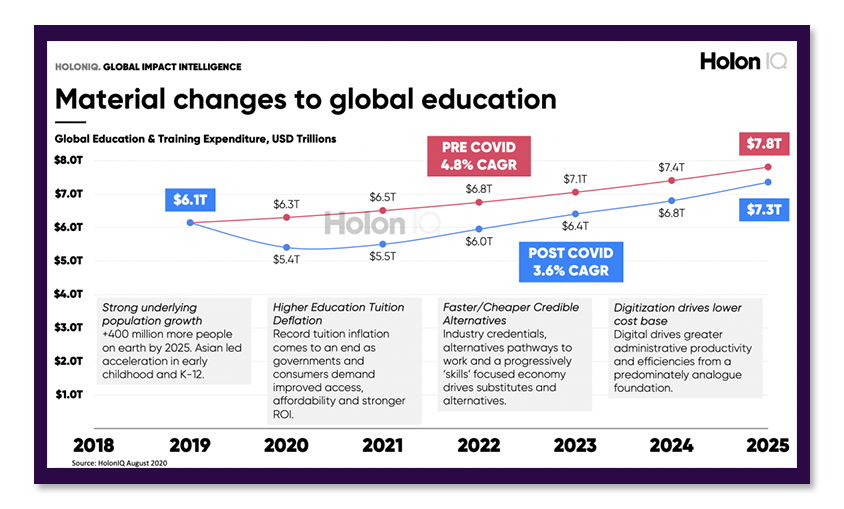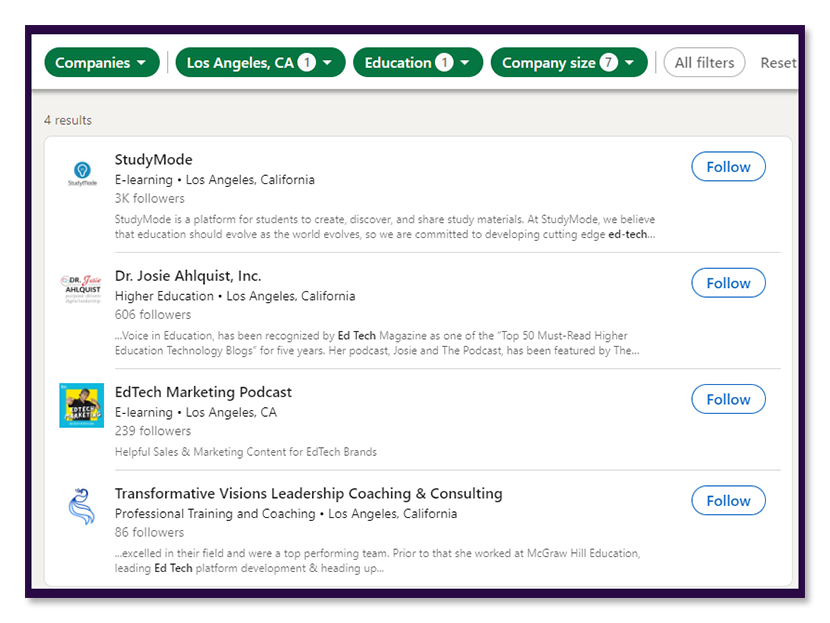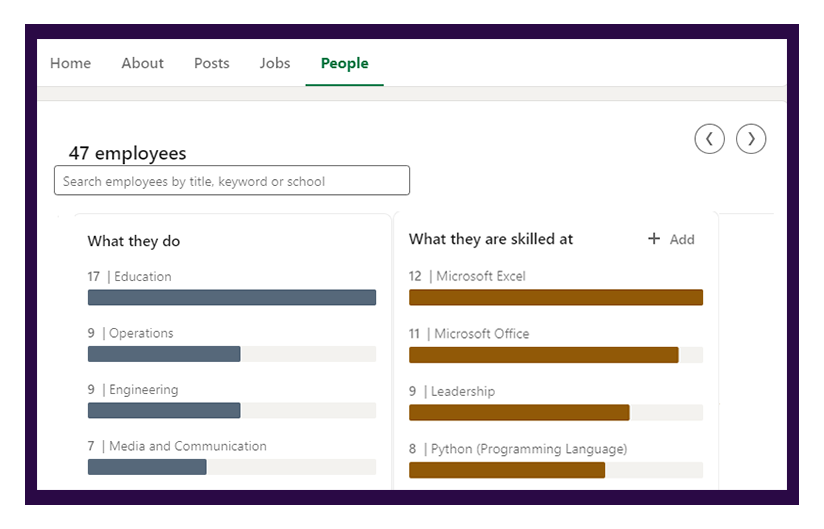
How to Identify Education Industry Decision-Makers: Your Go-to Guide
Are you struggling to track down and connect with the education industry decision-makers for your B2B business?
We understand how important it is to contact primary decision-makers if you want to market your amazing products or services to educational institutions successfully.
They hold the keys to unlock incredible opportunities for your business, and we’re here to help you navigate through this exciting maze of connections!
We have developed this comprehensive guide to assist you with just that. It will outline a simple 8-step process – enabling you to find and contact education industry decision-makers
How to Identify Decision Makers in the Education Industry?
Research projects the education industry to reach a whopping $4480 billion by 2027!
That's a lot of money invested in education. So, to tap into this growing market, you MUST know its key decision-makers.
This guide will give you an overview of 8 simple steps to connect with the decision-makers in education.
Identifying these individuals can make your business successful. After all, it is one of the first steps when you start designing your strategies for higher education lead generation.
And with Revnew, this job gets done in a jiffy! For instance, our team helped a course creation company promptly start discussions with relevant contacts.
To dive into the details, you can check out the entire case study on how Revnew’s 5-step approach enabled Pointful Education to set up 80 appointments in just four months!
So, are you ready to learn? Then, let’s get started.
Step 1: Research the Education Industry
Start by researching the sector itself. Commence by gaining a broad understanding of the educational landscape, including:
- The various types of educational institutions
- Their structures
- Recent trends and challenges
Look at industry reports, news articles, and academic research on the education industry. It can help you identify key market developments, such as:
- Changes in regulations
- Funding constraints
- Shifts in educational pedagogy
For example, when we researched the global state of the education sector, we found the following key drivers impacting its growth:

- Demand for improved access, affordability, and more substantial ROI for post-secondary learning
- Growing popularity of faster and cheaper education and upskilling alternatives
- Digitization leading to greater organizational productivity and efficiencies
- Short-term surge in spending due to COVID-19 leading to longer-term integration of digital technologies
- "Infrastructure catch-up" required for managing learning, data, and administration
- Rise of educational technology models for supplemental and/or more direct academic and career outcomes
- Consumer technology expectations (mobility, personalization, social, and gamified learning) underpinning the transition to digital
You should also stay up-to-date on industry news and events. It can help you identify new opportunities and know about changes that may impact the business.
For instance, you can attend education industry conferences or join relevant industry associations. You’ll gain valuable insights into the latest news about the sector.
Step 2: Identify ICPs
Next up. Understand your ideal customer profile (ICP) in the education sector. It involves defining the firmographic and behavioral characteristics of your target customers.
Firmographic characteristics include attributes such as:
- The size of the educational institution
- The level of education (e.g., K-12, higher education)
- The geographic location of the institution
Behavioral characteristics include factors such as:
- The pain points your product or service can address
- The budget of the institution
- The decision-making process within the organization
Nailing down your ICP allows you to focus your marketing efforts and resources on the most promising prospects. Identifying the key characteristics of your ideal customer enables you to tailor your messaging and outreach efforts – to resonate with their needs and priorities.
An illustration of ICP identification in education might involve creating a matrix or table that lists the following attributes:
- Your target customer's firmographic and behavioral characteristics
- Specific examples of institutions or decision-makers that fit that profile
It can help you visualize and prioritize your outreach efforts and refine your ICP over time based on your results.
For your better understanding, here’s a possible tabular format for developing an ICP:
| Criteria | Description |
| Educational institution size |
It includes factors such as the number of students, faculty size, and geographic location. For example, you might target small-to-medium-sized private colleges in the Northeastern United States. |
| Educational institution type |
It includes factors such as whether the institution is a K-12 school, community college, or university. For example, you might target K-12 schools focusing on STEM education. |
| Academic programs/initiatives |
Include identifying specific academic areas or initiatives your product or service can support. For example, you might target schools offering coding programs or transitioning to blended learning environments. |
| Budgetary constraints |
It includes understanding the typical budget constraints for educational products or services. For example, you may target institutions with a budget of $50,000 or more for educational technology purchases. |
| Decision-making processes |
It includes understanding who makes the purchasing decisions for products or services and what factors influence their choices. For example, you might target institutions where the IT department is responsible for educational purchasing decisions. |
Step 3: Build Your Account List
After identifying your ICP, create your account list. In other words, design a targeted list of educational institutions and decision-makers that fit your ICP criteria. Here's how:
- Use Online Tools to Identify Potential Accounts: Many online databases and directories can help you identify potential customers in your target market.
Use tools like LinkedIn Sales Navigator or Crunchbase to create a list of schools, colleges, universities, and other educational institutions that match your ICP.
- Research the Accounts: Once you have a list of potential accounts, research each one to learn more about their specific needs, budget, decision-making processes, and pain points.
This information will help you prioritize your outreach efforts and tailor your messaging to each account.
- Prioritize Your Outreach: Based on your research, focus your outreach efforts on the accounts that best fit your product or service. Then create a tiered list of accounts, with your highest priority accounts at the top.
- Develop Personalized Messaging: Use the information you have gathered about each account to develop personalized messaging that meets their specific requirements. It will increase the likelihood of a successful outreach effort.
- Track Your Progress: As you reach target accounts, track your progress using a CRM tool. It will help you stay organized and ensure that you are effectively engaging with each account.
Check out this illustration of an account list for your better understanding:
| Institution | Institution Type | Budget | Decision Maker | Pain Point |
| Oak Ridge High School | K-12 School | $100,000 | Director of Technology | Outdated software |
| San Francisco State University | University | $250,000 | Chief Information Officer | Difficulty managing student data |
| Harvard University | Ivy League University | $500,000 | Dean of Instructional Technology | Need for more engaging online learning tools |
| Khan Academy | Online Learning Platform | $50,000 | CEO | Need to improve user engagement |
| Miami Dade College | Community College | $150,000 | Chief Academic Officer | Lack of resources for students in underprivileged areas |
Step 4: Use LinkedIn
To find and connect with key decision-makers, use LinkedIn. It’s a powerful tool for B2B outreach, allowing you to target and engage with specific individuals who fit your ICP.
Here are the key steps to follow while using LinkedIn:
1. Search for Educational Institutions that Fit Your ICP: Use the search filters on LinkedIn to narrow down your results by location, industry, and size.
 2. Locate Specific Decision-makers Within Those Organizations: It may include searching for titles such as "Director of Technology" or "Chief Information Officer," depending on your specific product or service.
2. Locate Specific Decision-makers Within Those Organizations: It may include searching for titles such as "Director of Technology" or "Chief Information Officer," depending on your specific product or service.

3. Use LinkedIn's Messaging and Connection Features: Utilize these functionalities to reach out to decision-makers and introduce your product or service.
Personalize your message to reflect the specific needs and priorities of the educational institution. Additionally, highlight how your product or service can address their challenges.
4. Engage with Decision-makers: Comment on and share their posts and relevant industry news and content. It can help build credibility and establish a relationship with decision-makers over time.
Step 5: Leverage Educational Networks
Education industry associations and networks can provide valuable insights and connections. As such, they help you identify decision-makers, build relationships with them, and refine your lead generation tactics for higher education.
Here are some tried-and-tested tips:
- Pinpoint Relevant Institutions Specific to Education: These may include organizations such as the International Society for Technology in Education (ISTE) or the Consortium for School Networking (CoSN).
- Attend Industry Events: Participate in conferences etc., hosted by these organizations. Here, you can connect with decision-makers and stay up-to-date on industry trends and challenges.
Such events also offer valuable networking opportunities and insights into key stakeholder priorities.
- Build Relationships Over Time: It may involve participating in online forums or groups or contacting key individuals within these organizations – to introduce your product or service.
- Consider Partnerships: Partner with industry associations and networks to promote your product or service to a broader audience. It can help build your credibility. As such, you can establish your company as a thought leader in the education industry.
Step 6: Utilize Technology
Use technology to streamline the identification and outreach process. These tools can help you:
- Gather contact information for decision-makers
- Track their engagement with your company
- Close more deals in the education industry
Here are some examples of technology tools that help you pinpoint education industry decision-makers:
- ZoomInfo: It provides contact information – including email addresses and phone numbers. You can use this information to create targeted outreach campaigns and improve your chances of success.
- DiscoverOrg: It offers insights into educational institutions' organizational structure, including key decision-maker names and titles. You can use this information to identify the most relevant individuals to contact and tailor your messaging accordingly.
- HubSpot: It has a suite of marketing and sales automation tools, including email marketing, lead tracking, and analytics. You can use these tools to streamline your outreach efforts and track decision-makers' engagement with your company over time.
However, when using the above tools, you should follow best practices to maximize your chances of success. Here are some tips to remember:
- Use targeted outreach campaigns tailored to educational institutions' specific needs and pain points. It will increase your chances of success and reduce the likelihood of your messages being ignored or deleted.
- Track decision-makers' engagement with your company over time. Then use this information to refine your outreach strategies and improve your messaging.
- Use a mix of technology tools and personal outreach to build relationships with decision-makers in the education industry.
Note: Technology can be a powerful tool for streamlining the identification and outreach process. However, personal connections and relationships ultimately drive success in the education industry.
For further reading: How to generate education leads?
Step 7: Contact Decision-Makers
The penultimate step is to reach out to your decision-makers with a targeted and personalized message. It involves the following sub-steps:
- Developing messaging based on your ICP
- Researching education industry decision-makers
- Using a multi-channel approach to deliver that message in a way that stands out
Here’s an explanation of the above elements in further detail:
- Develop Messaging Based on ICP and Decision-maker Research: You must create a message that resonates with key players in the education industry. Hence, understand their requirements and challenges. In addition, learn about the specific solutions your company can offer.
Use the information you've gathered through your research to craft messaging that speaks directly to their needs. Plus, ensure your communication demonstrates the value of your product or service.
- Use a Multi-channel Approach: Follow a multi-channel strategy to increase the chances of your message being seen and responded to. It might include email, phone calls, social media outreach, and other tactics.
Using multiple channels enables you to increase the visibility of your message and improve your chances of success.
- Personalize Messaging to Stand Out: In a crowded market like the education industry, you need to personalize your messaging to stand out from the competition.
It might involve the following:
- Referencing specific pain points faced by the educational institution
- Using personalized language to establish a connection with the decision-maker
Personalizing your message demonstrates that you understand their needs and are committed to finding a solution that works for them.
Step 8: Build Relationships
Fostering solid relationships with decision-makers is vital to achieving long-term success in the education industry. It can lead to repeat business, referrals, and other valuable opportunities.Here are some tips for following up and nurturing relationships with decision-makers over time:
- Stay in Touch: Regularly reach out to decision-makers and keep them updated on your products or services. It can help build a sense of trust and reliability. Plus, use a variety of channels, including email, phone calls, and social media, to stay in touch and keep the lines of communication open.
- Provide Value: Strive to offer value beyond your products or services. Share industry insights, offer educational resources, or provide personalized support – to help address specific pain points or challenges.
- Listen and Respond: When communicating with decision-makers, take the time to listen to their needs and concerns. Respond thoughtfully and address their concerns. It can help build trust and establish your company as a trusted partner in the education industry.
- Be Patient: Building strong relationships with decision-makers takes time. Don't expect immediate results, and focus on building relationships gradually over time. It may involve multiple touchpoints and interactions before a decision-maker can commit to your product or service.
Take Your Educational Business to New Heights With Revnew!
Identifying education industry decision-makers is vital for any business looking to succeed in this dynamic market. The education sector is constantly evolving. Factors such as digitization, budgetary constraints, and changing consumer demands shape its growth trajectory.
However, with the right approach to education industry lead generation, you can stay ahead of the competition and unlock new opportunities for success. That's where Revnew comes in as your partner of choice for education lead generation.
Our proprietary process ensures your academic product/service reaches the right decision-makers – to influence even more potential customers and achieve your goals. So don't wait any longer to skyrocket your educational solutions. Contact us today!
Read more: Ways to Generate Education Leads Through Outbound Marketing


![11 Strategies to Find B2B Decision Makers [Bonus Added]](https://revnew.com/hs-fs/hubfs/Revnew/Images/other%20img/How-to-Find-b2b-decision-makers-in.jpg?width=352&name=How-to-Find-b2b-decision-makers-in.jpg)

